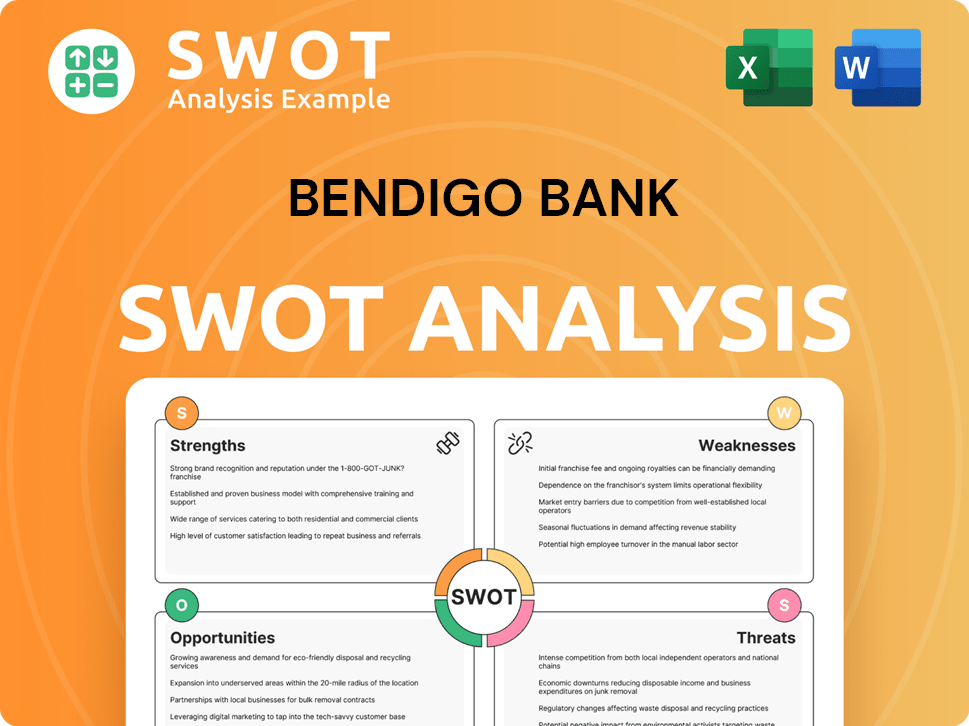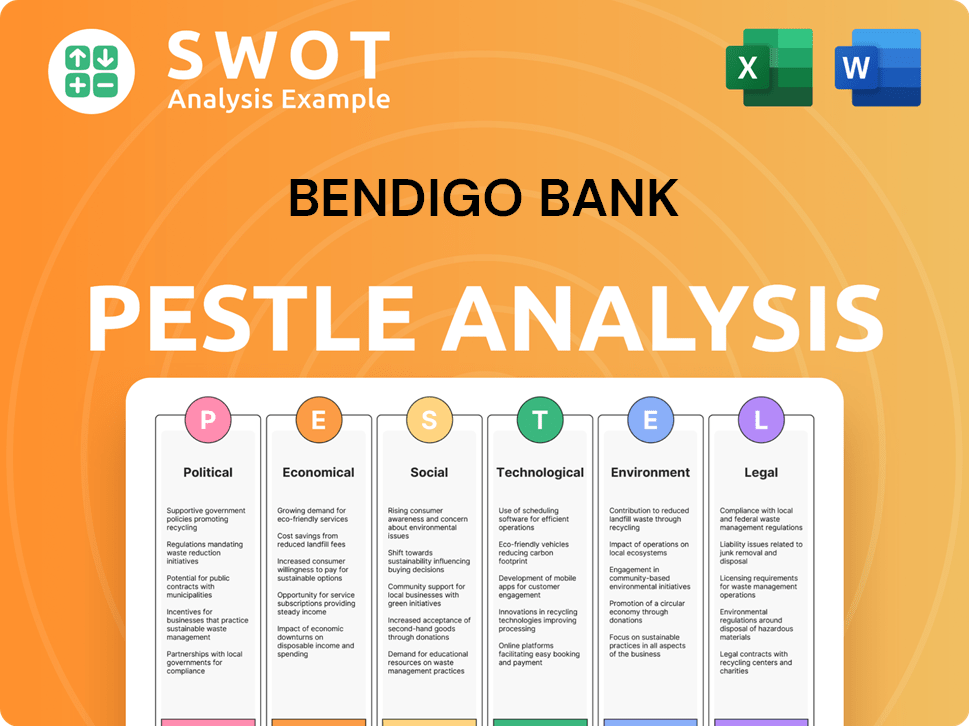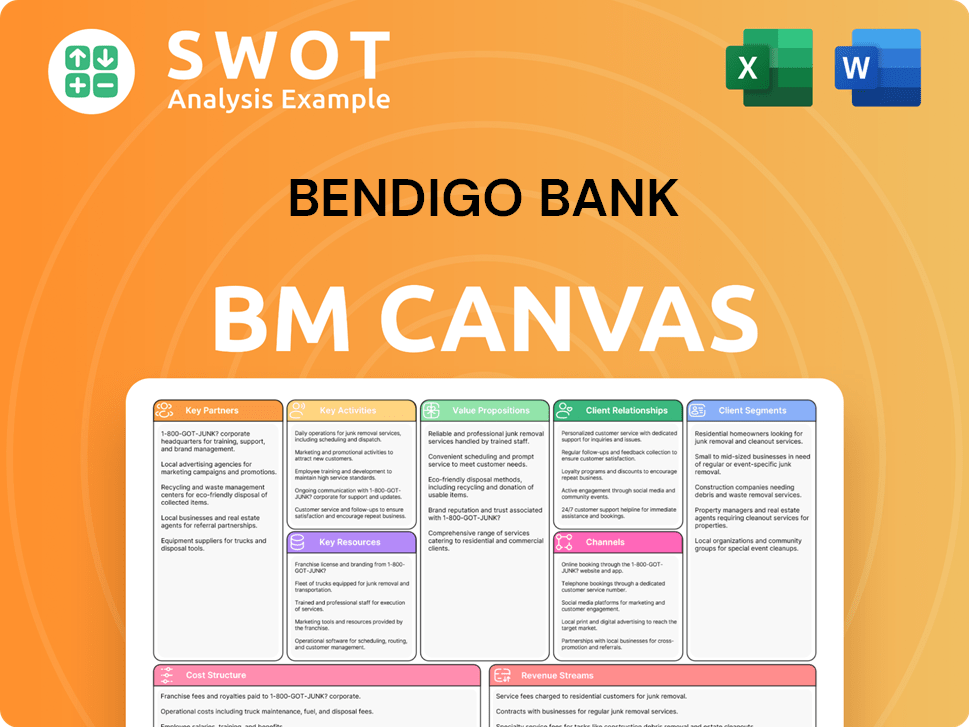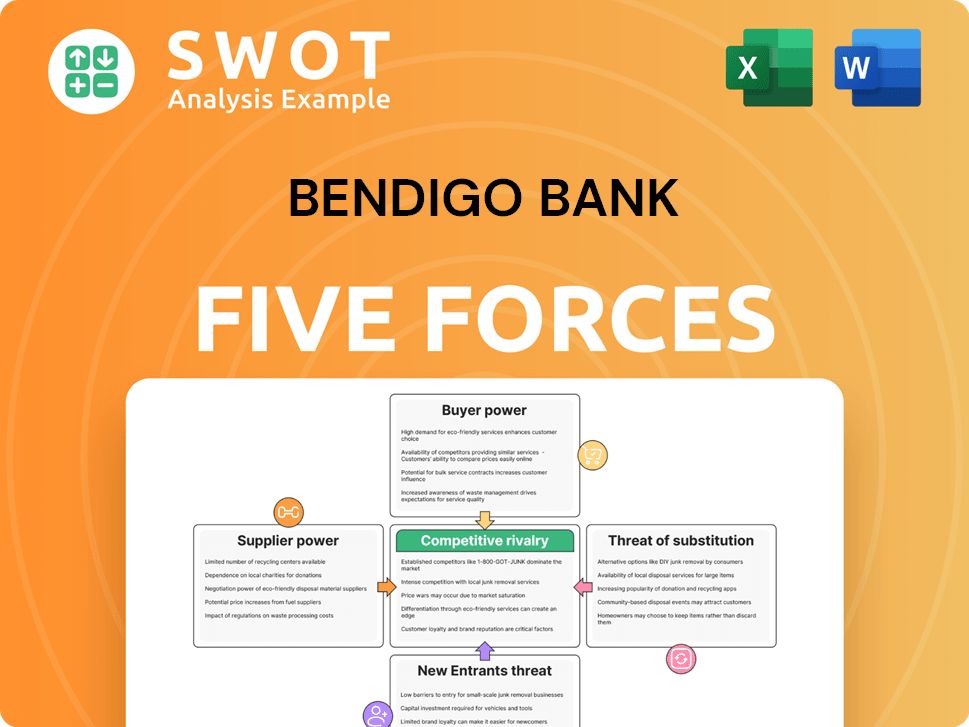Bendigo Bank Bundle
Can Bendigo Bank Continue Its Ascent in the Australian Banking Sector?
Founded during the Victorian gold rush, Bendigo and Adelaide Bank has evolved from a building society to a major Australian bank, serving millions. Its unique Community Bank model, a cornerstone of its identity, has injected hundreds of millions back into local communities. This journey, however, sets the stage for an in-depth look at its future.

To understand the trajectory of this financial institution, we delve into the Bendigo Bank SWOT Analysis, exploring its growth strategy and future prospects. This analysis will examine the bank's strategic initiatives, including its digital transformation strategy and customer acquisition strategies. We'll also assess its financial performance review, market share and trends, and its long term growth potential within the competitive landscape.
How Is Bendigo Bank Expanding Its Reach?
The expansion initiatives of Bendigo Bank are designed to drive future growth by leveraging a multi-channel approach. This strategy includes retail branches, digital platforms, and partnerships to broaden its reach and customer base. The bank's focus on these areas aims to capitalize on opportunities for sustainable growth and enhance its position in the market.
A key element of Bendigo Bank's growth strategy involves significant investments in its digital capabilities. This includes the ongoing development of its digital brand, Up, and the enhancement of its digital mortgage offerings. These efforts are aimed at attracting a broader customer base and improving operational efficiency.
Furthermore, the bank is committed to supporting regional communities and fostering local economic development. Strategic partnerships, such as the one with Runway, demonstrate its commitment to supporting regional startups and expanding its business banking relationships. This approach aligns with Bendigo Bank's broader mission to contribute to the prosperity of the communities it serves.
Residential lending showed strong growth in the half-year ending December 2024. Flows increased to $10.1 billion, with the residential loan book reaching $65.2 billion, up 5.3% from 2H24. This growth reflects the effectiveness of the Bendigo Lending Platform and the increasing demand for home loans.
Digital mortgages accounted for 19% of all settled mortgages in the half-year ending December 2024. This indicates a significant shift towards digital channels and the increasing adoption of online services by customers. The bank is leveraging digital transformation to improve customer experience and streamline processes.
The digital brand, Up, continues to be a significant growth engine, surpassing 1 million customers after just six years. Customer numbers grew by 13.2% half-on-half. This rapid growth highlights the success of Up in attracting and retaining customers in the digital banking space.
Up's deposits increased by 22.6% to $2.6 billion, and home loans substantially increased to $1.2 billion. These figures demonstrate the increasing financial activity within the Up platform. The bank plans to continue investing in Up to drive further growth.
In the business and agribusiness sector, the bank is implementing strategic initiatives to support growth. While lending contracted by 3% in the half-year ending December 2024, the establishment of a 'business direct' team and the migration of Rural Bank customers are expected to boost performance. These efforts are part of Bendigo Bank's broader strategy to maintain a strong presence in the market and achieve sustainable growth. A closer look at the Competitors Landscape of Bendigo Bank can provide additional insights into the competitive environment.
Bendigo Bank's expansion strategy includes leveraging its multi-channel approach, focusing on digital growth, and supporting regional communities. These initiatives are designed to drive growth across various segments and enhance customer engagement.
- Residential lending growth supported by the Bendigo Lending Platform.
- Digital mortgages contributing significantly to settled mortgages.
- Continued investment in Up to drive deposits and home loans.
- Establishment of a 'business direct' team to enhance customer experience.
- Strategic partnerships to support regional startups and economic development.
Bendigo Bank SWOT Analysis
- Complete SWOT Breakdown
- Fully Customizable
- Editable in Excel & Word
- Professional Formatting
- Investor-Ready Format

How Does Bendigo Bank Invest in Innovation?
The innovation and technology strategy of the company is a key driver for its sustained growth and competitive advantage. This strategy is underpinned by significant investments in technology and a multi-year transformation program. The goal is to reduce operational complexity and enhance digital and risk management capabilities, with key deliverables expected by 2025.
A central element of the company's strategy involves consolidating operations onto a single core banking system. This initiative is expected to modernize data and technology platforms and automate core processes. The company is also heavily focused on digital transformation, with the aim of increasing the delivery of electronic statements. Furthermore, the company is leveraging advanced technologies like AI to modernize legacy applications and support its transition to an AI-enabled cloud infrastructure.
The successful rollout of the Bendigo Lending Platform is a testament to the impact of these investments, supporting substantial home lending growth. The company is also leveraging cutting-edge technologies like AI to rewrite legacy applications and support its transition to an AI-enabled cloud infrastructure. The company's digital neobank, Up, serves as an innovation hub, demonstrating the power of innovative banking with unique features that resonate with a younger demographic and reinforce the company's commitment to digital transformation.
The company is consolidating operations from eight banks into a single core banking system by 2025. This is a major step in modernizing data and technology platforms. The migration of approximately 95% of customers onto a single retail finance core banking system has already been achieved.
The company is targeting 90% of statements to be delivered electronically by 2025. The Bendigo Lending Platform rollout has significantly supported home lending growth. Digital solutions like the BEN Express digital home loan are streamlining critical customer journeys, such as home ownership.
The company plans to migrate 50% of its applications to Amazon Web Services and Google Cloud by 2024. Over 80% of new and upgraded applications are already 'born in the cloud'. AI is being utilized to rewrite legacy applications, supporting the transition to an AI-enabled cloud infrastructure.
The digital neobank, Up, serves as an innovation hub. It showcases innovative banking features that attract a younger demographic. This reinforces the company's commitment to digital transformation and its efforts to enhance its Target Market of Bendigo Bank.
The company's innovation strategy is focused on several key areas to drive growth and maintain a competitive edge. These initiatives are designed to improve operational efficiency, enhance customer experience, and adapt to evolving market demands. The investment in technology is a crucial part of the company’s overall strategy.
- Core Banking Modernization: Consolidating core banking systems to streamline operations and improve data management.
- Digital Transformation: Enhancing digital capabilities to improve customer experience and operational efficiency.
- Cloud Adoption: Migrating applications to cloud platforms to improve scalability, flexibility, and cost-effectiveness.
- AI and Automation: Leveraging AI and automation to optimize processes and improve decision-making.
- Digital Lending Platforms: Utilizing digital platforms to streamline lending processes and improve customer access to financial products.
Bendigo Bank PESTLE Analysis
- Covers All 6 PESTLE Categories
- No Research Needed – Save Hours of Work
- Built by Experts, Trusted by Consultants
- Instant Download, Ready to Use
- 100% Editable, Fully Customizable

What Is Bendigo Bank’s Growth Forecast?
The financial outlook for the company, as of early 2025, indicates a strategic focus on long-term growth, despite facing some short-term pressures. The company is actively investing in its transformation program and managing margin pressures to support its lending growth. This approach is designed to position the company for sustained success in the evolving financial landscape.
For the half-year ending December 31, 2024, the company reported cash earnings of $265.2 million and a statutory net profit after tax of $216.8 million. While cash earnings saw a slight decrease, the company's residential lending book grew significantly, demonstrating strong demand. Customer deposits also experienced substantial growth during this period.
The company's residential lending book grew by 5.3% to $65.2 billion by the end of December 2024, reflecting robust demand in the market. Customer deposits also saw a significant increase, growing by 5.4% to $72.0 billion during the same period. These figures highlight the company's ability to attract and retain customers, which is crucial for long-term growth.
The company's financial performance demonstrates resilience and strategic investment. The company reported cash earnings of $265.2 million and a statutory net profit after tax of $216.8 million for the half-year ending December 31, 2024.
Residential lending grew by 5.3% to $65.2 billion, and customer deposits increased by 5.4% to $72.0 billion by the end of December 2024. These figures reflect strong customer confidence and market demand.
NIM decreased by 6 basis points to 1.88% in the half-year ending December 2024. The company has improved its risk-based pricing capability in residential lending to manage this.
For FY24, the company reported a statutory net profit after tax of $545.0 million, up 9.7%, and cash earnings of $562.0 million, down 2.6% from FY23. The full-year dividend was 63 cents per share, a 3.3% increase.
The company plans to increase investment spending in FY25 and FY26 by $30 million to $40 million from FY24 levels, with a focus on enhancing its digital capabilities. The company is committed to its medium-term targets of reducing its cost-to-income ratio to 50% and increasing its return on equity above its cost of capital. These strategic investments are designed to drive future growth and improve operational efficiency.
The company is increasing investment spending in FY25 and FY26 by $30 million to $40 million, primarily focusing on improving digital capabilities to enhance customer experience and operational efficiency.
The company aims to reduce its cost-to-income ratio to 50% and increase its return on equity above its cost of capital. These targets reflect a commitment to improving profitability and shareholder value.
Analysts forecast the company to grow earnings and revenue by 3.2% per annum, with EPS expected to grow by 3.3% per annum. Return on equity is forecast to be 7.1% in three years, indicating strong growth potential.
The company's balance sheet remains strong, with a Common Equity Tier 1 ratio of 11.17% as of December 2024, well above regulatory requirements. This provides a solid foundation for future growth and stability.
The full-year dividend for FY24 was 63 cents per share, a 3.3% increase from the previous year. This demonstrates the company's commitment to returning value to shareholders.
The company's focus on digital transformation and strategic investments supports its long-term growth strategy, ensuring it remains competitive in the financial services sector.
The company's strong balance sheet, with a Common Equity Tier 1 ratio of 11.17% as of December 2024, provides a solid foundation for future growth. The company's focus on digital capabilities and strategic investments, as outlined in the Mission, Vision & Core Values of Bendigo Bank, supports its long-term growth strategy.
Bendigo Bank Business Model Canvas
- Complete 9-Block Business Model Canvas
- Effortlessly Communicate Your Business Strategy
- Investor-Ready BMC Format
- 100% Editable and Customizable
- Clear and Structured Layout

What Risks Could Slow Bendigo Bank’s Growth?
Several risks and obstacles could impact the growth strategy of the company. Intense competition in the mortgage market and other financial sectors could squeeze profits. Additionally, regulatory changes and the overall economic climate present ongoing challenges to the company. These factors could affect the company's financial performance.
The company's transformation program, while crucial for future growth, also involves increased spending in the short term. Rising costs and external economic factors, such as fiscal policy constraints and trade wars, could further complicate the company's outlook. The company's leadership is actively working to address these issues.
The company expects official interest rates to return to a neutral level of around 3.5% by the end of 2025. The bank anticipates residential arrears to gradually increase and bad and doubtful debts to move towards longer-term averages. Home loan customers are generally well ahead on repayments (42% one year ahead as of December 2024).
The company faces fierce competition, especially in the mortgage market, which could pressure its income and margins. This competitive landscape requires the company to continually adapt its strategies to maintain its market share. Analyzing the competitive landscape is crucial for understanding the challenges.
The company's Net Interest Margin (NIM) has been negatively affected by the higher costs of deposits and increased wholesale funding costs. Managing the NIM is vital for the company's financial performance. These financial pressures require careful financial performance review.
Regulatory changes and the evolving economic outlook present ongoing challenges. The company must adapt to these changes to maintain compliance and profitability. Understanding these factors is essential for investors seeking investment opportunities.
The extensive multi-year transformation program involves increased investment spending, which may lead to a higher cost-to-income ratio in the short term. While this program is vital for future growth, it presents immediate financial challenges. The company's digital transformation strategy is key.
Global economic uncertainties, such as fiscal policy constraints and trade wars, pose risks to the company's outlook. These external factors can significantly impact the company's financial performance. A thorough market analysis is necessary to navigate these uncertainties.
The company anticipates residential arrears to gradually increase, with bad and doubtful debts moving towards longer-term averages. Monitoring these trends is crucial for assessing financial health. The company's business model needs to consider this.
The company is actively addressing these risks through disciplined investment, a focus on productivity improvements, and maintaining a strong balance sheet. These strategies are designed to improve operational efficiencies. The company's leadership and management are key to success.
The company's continued investment in digital capabilities and its transformation program aims to reduce complexity and improve operational efficiencies. These initiatives are designed to mitigate challenges. Read more about the company's initiatives in this comprehensive article about the company's growth strategy.
Bendigo Bank Porter's Five Forces Analysis
- Covers All 5 Competitive Forces in Detail
- Structured for Consultants, Students, and Founders
- 100% Editable in Microsoft Word & Excel
- Instant Digital Download – Use Immediately
- Compatible with Mac & PC – Fully Unlocked

Related Blogs
- What are Mission Vision & Core Values of Bendigo Bank Company?
- What is Competitive Landscape of Bendigo Bank Company?
- How Does Bendigo Bank Company Work?
- What is Sales and Marketing Strategy of Bendigo Bank Company?
- What is Brief History of Bendigo Bank Company?
- Who Owns Bendigo Bank Company?
- What is Customer Demographics and Target Market of Bendigo Bank Company?
Disclaimer
All information, articles, and product details provided on this website are for general informational and educational purposes only. We do not claim any ownership over, nor do we intend to infringe upon, any trademarks, copyrights, logos, brand names, or other intellectual property mentioned or depicted on this site. Such intellectual property remains the property of its respective owners, and any references here are made solely for identification or informational purposes, without implying any affiliation, endorsement, or partnership.
We make no representations or warranties, express or implied, regarding the accuracy, completeness, or suitability of any content or products presented. Nothing on this website should be construed as legal, tax, investment, financial, medical, or other professional advice. In addition, no part of this site—including articles or product references—constitutes a solicitation, recommendation, endorsement, advertisement, or offer to buy or sell any securities, franchises, or other financial instruments, particularly in jurisdictions where such activity would be unlawful.
All content is of a general nature and may not address the specific circumstances of any individual or entity. It is not a substitute for professional advice or services. Any actions you take based on the information provided here are strictly at your own risk. You accept full responsibility for any decisions or outcomes arising from your use of this website and agree to release us from any liability in connection with your use of, or reliance upon, the content or products found herein.